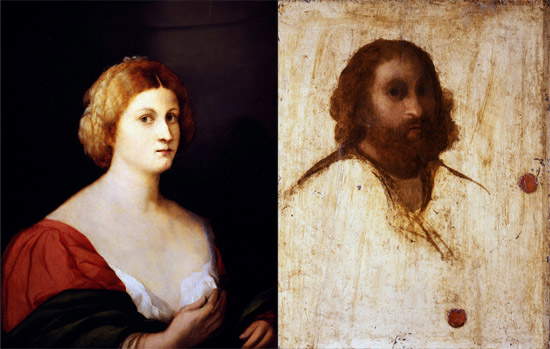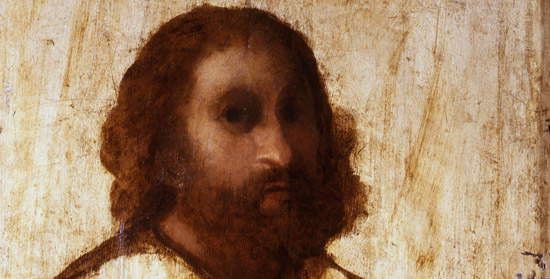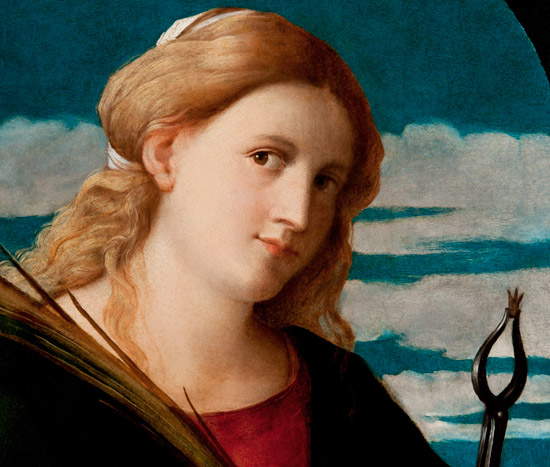At the recent exhibition on Palma the Elder (c. 1480 - 1528, real name Jacopo Negretti), held at GAMeC in Bergamo, there was on display, among others, an important and interesting painting, the so-called Unfinished Portrait, kept at the Uffizi. It is an oil on panel painting painted on both sides: on the recto, that is, the front side, we have a female portrait, while on the verso, that is, the back side, there is a male portrait. Both are unfinished, but perhaps it is precisely this unfinishedness that is the main reason for the interest of this painting: because to see an unfinished painting is to see a painting in the course of its execution, and this peculiarity allows us to draw a considerable amount of information about the technique used by the painter to make his paintings.
Knowledge of an artist’s technique is crucial in several respects: suffice it to say that knowing the way the artist painted is crucial to making the best possible restoration work, if any, that a work requires. From the materials and colors the painter used, we can understand what circles a work was intended for (just think of the fact that certain pigments were very expensive and thus could be used in paintings required only by wealthy patrons), and thus who the artist’s main stakeholders were. And of course we can understand how demanding and difficult the work is that requires a fineness, quality and precision that only great painters can achieve.
 |
| Palma il Vecchio, Unfinished Female Portrait (recto) and Unfinished Male Portrait (verso); c. 1514; Florence, Uffizi |
Let us see, then, how Palma the Elder made his paintings: it is, moreover, a technique common to many other painters of his contemporaries. The very first stage was, clearly, the choice of support: Palma painted mainly on poplar wood panels, but sometimes he did not disdain the use of canvas. Often the work already began with the choice of wood: especially when it came to painting works of considerable size, it was not easy to find boards in excellent condition, ready and uniform, and therefore it was necessary to join together boards of different sizes, trying to achieve a result that was as balanced as possible and taking care to sand the surface of the support well in order to obtain the ideal flatness. The choice of poplar wood was not accidental: it is in fact one of the woods with the lowest risk of imperfections (such as knots, holes, deformations and whatnot). But it still happened to find them, and it was therefore necessary to fix them: knots, for example, were removed as they were more prone to decay than the “healthy” parts of the board, and they were “putty” with a mixture of wood sawdust and glue, and the same procedure was applied to the small holes that could be found on the surface of the board.
This done, the painter would begin to prepare the support so that it could receive the paint. Since painting directly on wood would have been quite difficult and, above all, a paint given directly on the board would have been ruined much more quickly, the artist would perform the so-called imprimitura, an operation by which one or more layers of material were placed on the surface of the support to create a base that could receive the paint. The imprimitura performed by Palma the Elder had ancient origins: the painter made one or more layers of animal glue and plaster adhere to the support. The fine gesso was used to create, precisely, a grayish-colored base on which to finally begin working. Dyes could be applied to the gesso so that a certain shade could be given to the finished result: however, this was not the case for Palma the Elder, who preferred to work on bases with gray tones.
The support was then ready: Palma the Elder began by tracing, on the base, the outlines of the painting he had in mind. This was done with the use of a brush. Subsequently, unlike many painters who first arranged the colors of the background on the base and then did the details, Palma preferred to concentrate on large areas of the painting by completing them separately. We can clearly see this by looking at his Unfinished Portrait of a Man: we can easily see that the face is already almost finished, since the painter has by now also studied the arrangement of light and shadow and painted with exceptional care even the curls of the beard, whereas in the other areas there are only the traces arranged by the artist on the last layer of imprimitura.
 |
| Palma the Elder, Unfinished Male Portrait, detail |
Once the painting was finished, the painter covered his work with a coat of protective varnish, which had the dual task of making the colors shinier (while also accentuating the contrasts between light and shadow) and preserving the painting from the degradation it would undergo with the passage of time. It is these steps, most often slow and meticulous, that enabled Palma the Elder to create his greatest masterpieces: colorful, luminous and highly refined paintings, but at the same time also fragile. Many of them, despite the painter’s shrewdness, have shown conservation problems that have led to consequent restoration work. But it is precisely the knowledge of the painting technique used by the painter that has allowed the technicians to return us colors that are entirely similar to those that Palma might have originally studied for his works. This is the case of the last restoration carried out on a work by Palma il Vecchio, the Saint Apollonia of the Serina Polyptych, which had lost some pieces of the pictorial surface, which had fallen over the centuries, and had experienced some repainting that had altered its colors: the intervention, which was also possible thanks to a profound knowledge of the procedures adopted by the painter, has returned to us a Saint Apollonia as it must have been when the painter painted it. The importance of the restoration was such that the painting was presented at the Bergamo exhibition and was, moreover, taken as an example to illustrate Palma il Vecchio’s technique to visitors.
 |
| Palma il Vecchio, Saint Apollonia (detail), from the Polyptych of the Presentation of the Virgin; 1515-1517; Serina, Santa Maria Annunciata |
Warning: the translation into English of the original Italian article was created using automatic tools. We undertake to review all articles, but we do not guarantee the total absence of inaccuracies in the translation due to the program. You can find the original by clicking on the ITA button. If you find any mistake,please contact us.